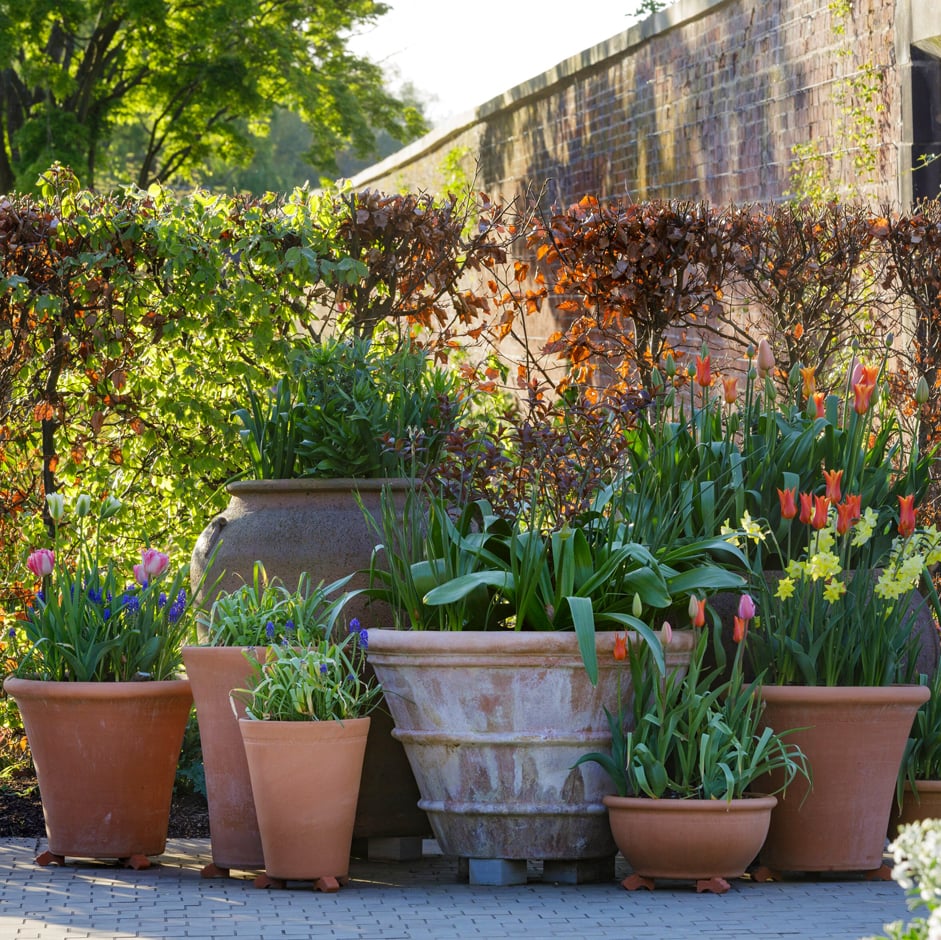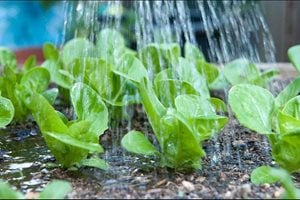New show coming to Rotherham: RHS Flower Show Wentworth Woodhouse
RHS Member tickets from £26.85, plus online booking fee. Under 16s go free!
Growing guide
How to grow forsythia
Forsythias are hardy, robust shrubs known for their abundant yellow flowers produced on bare stems in early spring. Whether you’re growing forsythia as a free-standing shrub or a hedge, this guide will help you get the best from this popular garden plant.
Quick facts
- Hardy and easy to grow
- Produces a mass of yellow flowers in early spring
- Tolerant of a wide range of soils
- Grow in full sun or light shade
- Prune after flowering
- Good choice for a flowering hedge
- Take cuttings to produce new plants
All you need to know
Choosing a forsythia
You might think that forsythias are all very similar, covered as they are in masses of golden-yellow flowers in early and mid-spring. There are some subtle differences, however, and here are some things to consider before buying:
-
Plant height – forsythias are usually tall, vigorous shrubs reaching about 2m (6⅔ft) in height if left unpruned. If space is tight, there are several smaller cultivars, including F. × intermedia Minigold (‘Flojor’) at 60cm (2ft) tall and F. ‘Fiesta’ at 1–1.2m (3⅓–4ft) tall and with
variegated leaves. Both of these could also be grown in containersVariegated means having leaves or other plant parts with streaks, blotches or patches of different colours. Typically, these would be a combination of two colours, such as green and gold or green and white.
-
Style of growth – for a forsythia hedge, choose a strong upright
cultivar such as F. × intermedia ‘Lynwood Variety’ or F. × intermedia ‘Spectabilis’Gardeners often use the word variety when referring to a specific plant, but the correct botanical term is 'cultivar'. Whichever word you use, it means a distinctive plant or plants, given a specific cultivar name and usually bred to enhance certain characteristics, such as flower or fruit size, colour, flavour or fragrance, plant size, hardiness, disease resistance, etc. Additionally, it is worth knowing that, botanically, variety has another meaning - it refers to a naturally-occurring distinct plant that only has slight differences in its looks. For example, Malva alcea var. fastigiata differs from typical plants by having an upright habit.
-
Flower colour and size – forsythias all have yellow flowers, but a few cultivars offer different shades of yellow or larger-than-normal flowers. Forsythia suspensa f. atrocaulis, for example, has pale lemon flowers, while F. × intermedia 'Goldrausch' has noticeably bigger flowers
To browse photos and descriptions of many forsythia cultivars, go to RHS Find a Plant. You can also search by size, planting position and RHS Award of Garden Merit, to help narrow down your choices.
Top Tip
If you want to grow forsythia against a wall, try F. suspensa and its cultivars, which tend to be less dense and have more flexible stems. You’ll need horizontal wires or trellis to tie the stems to, so you can spread them out across the wall.
How and what to buy
Single shrubs
Forsythias are widely sold in garden centres, nurseries and online by mail order. They are usually container-grown plants, in 2–3 litre pots, although larger plants may sometimes be available. When selecting a plant to buy:
-
Look for a balanced shape, with evenly spaced branches
-
Avoid plants showing signs of stress, damage or disease, such as broken shoots or yellowing leaves
-
Check for healthy roots – there should be enough roots so that they’re visible through the holes in the base of the pot, but they shouldn’t be so congested that you can’t see any soil
For hedging
Forsythia is sometimes available as bare-root plants from online hedging suppliers during the
Dormancy refers to a period of inactivity in plants, during which they slow down or stop their growth, conserving energy and resources. This is a natural process that helps them survive harsh conditions, such as winter or drought. Dormancy in seeds is a mechanism that prevents them germinating until environmental conditions are favourable for growth.
The plants are usually about 60cm (2ft) tall and must be planted as soon as they are delivered.

Forsythia for hedging
These small plants settle in more rapidly than larger plants, which may struggle to get established, especially during hot summers. However, if you want to create a hedge quickly, buying semi-mature plants gives a more immediate effect.
Buying: garden centre plants
Buying: mail order plants

Buying: trees and shrubs

RHS guide to buying healthy plants
When to plant
-
The best time to plant container-grown forsythias is in spring or autumn. However, they can be planted at any time, as long as the soil isn’t frozen, too wet, or excessively dry in summer. If you buy a forsythia in summer, plant it as soon as possible and water it regularly to keep the soil moist but not soggy – don’t let it dry out, as this could kill the plant
-
Plant bare-root forsythias in mild periods between November and February. Plant them as soon as possible after they are delivered
Where to plant
Forsythias are easy-to-grow, versatile shrubs that work well in many positions in the garden. They can add height in mixed borders, be trained against walls and grown as stand-alone specimens or hedges.
Bear in mind the following when choosing a planting site:
-
Forsythias thrive in most types of soil, except waterlogged ground
-
They prefer a sunny spot, but will tolerate light shade. However, forsythias in shade produce fewer flowers than those in sun
-
They are very hardy, so cope well in cold locations
-
Most will eventually grow to about 2m (6½ft) tall and wide, so allow enough space if you want your plant to develop its natural shape, or be prepared to prune it annually after flowering (see Pruning and Training below)
-
To make a dense, formal hedge, space plants 45–60cm (18in–2ft) apart. If you’re prepared to wait for them to knit together or want a less formal look, you can space plants more widely, up to 90cm (3ft) apart
How to plant
Forsythias are easy to plant, using the standard method for planting any shrub, hedge or container. Simply follow our step-by-step guides:

Hedges: planting

Growing plants in containers

Trees and shrubs: planting
Watering
Like most shrubs, newly planted forsythias should be watered regularly and thoroughly for the first few years, until their roots are well established. This is particularly important during dry spells in spring and summer.
Once established, forsythias are fairly drought tolerant and shouldn’t generally need additional watering. However, on very free-draining soil or during prolonged hot, dry spells, some extra water may be needed to support continued healthy growth. Look out for shrivelled leaves, which may be a sign your forsythia needs watering.
Top Tip
If the weather has been dry and your forsythia needs watering, give it a thorough soaking once or twice a week rather than watering little and often.

RHS video guide to watering efficiently
Feeding and mulching
Forsythias generally need little or no regular feeding in most types of soil.
However, to encourage strong new growth after pruning in spring, you may wish to feed. In which case, sprinkle a granular fertiliser such as Growmore around the plant, at the rate recommended on the packet.
Then add a mulch on top – a 5cm (2in) layer of organic matter, such as home-made compost or well-rotted manure. Leave a mulch-free circle immediately around the base of the plant to prevent the stems rotting.

How to feed plants

Mulches and mulching
Without regular pruning, forsythias tend to develop into tall, ungainly shrubs with congested growth and bare stems at the base. Flowering performance declines and any flowers are mostly borne on long, vigorous shoots at the top of the plant.
Still, pruning forsythias is quite straightforward, whether you have a free-standing shrub, a wall-trained shrub, an overgrown specimen or a hedge. Simply follow our advice below.
Pruning young forsythia plants
Allow young plants to develop naturally with minimal pruning. Just remove any dead, damaged or badly positioned shoots in late spring after flowering.
Pruning established forsythias
Prune in mid-spring, immediately after flowering – avoid pruning later in the year, as the following spring’s flowers will be reduced. Annual pruning keeps plants healthy, shapely and within bounds:
-
Cut back flowered growth to vigorous upward- and outward-facing shoots lower down
-
Also remove up to one-fifth of the oldest stems from the base of the plant. This will encourage strong new shoots to sprout from the base
-
Thin out any crowded shoots in the centre of the bush and remove any weak growth
-
If you wish to avoid pruning, choose a dwarf cultivar such as ‘Fiesta’, which needs very little pruning
For more tips, see our guide below.
RHS guide to pruning early flowering shrubs
Pruning neglected forsythias
If your forsythia has grown too large, is mis-shapen or badly congested, you can give it a new lease of life by hard pruning. It’s best to carry this out during the dormant season, between autumn and early spring, but bear in mind that the plant won’t produce any flowers in the first spring after such pruning.
You can either prune the entire shrub in one year or, if you would like to keep some of the existing structure and flowers, then spread the pruning over two years.
Our guide to renovating shrubs below takes you step-by-step through this process.
RHS guide to renovating shrubs
Pruning forsythia hedges
These should be pruned annually, in the same way as stand-alone shrubs:
-
Cut back the flowered shoots immediately after flowering, aiming to restore the outline of the hedge
- Remove a few of the oldest stems, to stimulate new replacement shoots from the base

Step-by-step RHS guide to hedge trimming
Pruning wall-trained forsythias
The aim is to develop a framework of stems to cover the desired space, trained to horizontal wires or trellis attached to the wall or fence:
-
Straight after flowering, reduce the length of the flowered stems to one or two buds from the branches that form the main framework
-
If older framework branches flowered poorly, cut them out and select younger shoots as replacements
-
Tie these new stems into the desired position, to fill any gaps or extend the area covered
Climbers and wall shrubs: pruning established plants
From cuttings
Taking cuttings is an easy way to make new forsythia plants. The resulting plants will be exactly the same as the parent, which is useful if you need to fill gaps in a forsythia hedge.
There are three different types of cutting, depending on the time of year:
-
Take softwood cuttings from late spring to early summer, selecting young, healthy, non-flowering shoots. Rooting takes two to four weeks. Grow them on in pots for planting out the following season
-
Take semi-ripe cuttings from midsummer to early autumn, rooting these directly into small pots and overwintering in a coldframe or unheated greenhouse. Pot on young, well-rooted cuttings in spring
-
Take hardwood cuttings from mid-autumn to late winter. These will be the slowest to root – simply leave them undisturbed in their pots until the following autumn
Forsythia cuttings taken by any method will root more quickly if given bottom heat in an electric propagator.
For more information on these techniques, see our handy guides below.
Cuttings: semi-ripe
Cuttings: hardwood
Cuttings: softwood
By layering
This is a useful technique for shrubs that have low-growing or flexible stems, such as Forsythia suspensa. It is very simple, with little ongoing maintenance required:
-
In spring or autumn, find a low-growing stem that can be bent down to the ground, then pin it to the soil surface with a loop of wire
-
Keep the soil moist to encourage rooting, which will usually take six months or more
-
Once the new plant is firmly rooted, the connecting stem to the parent plant can be cut and the new plant moved to a new location
For more information, see our guide below.
RHS guide to layering
From seed
This is a slower way to grow new forsythia plants, and the offspring may differ slightly from the parent plants. But it is well worth a try:
-
Once the seed pods are ripe and split open, collect the seeds
-
Store the seeds until autumn, then sow in a seed tray outdoors, allowing natural winter chilling to break their dormancy
- Seedlings should appear in spring
Seed: collecting and storing

Trees and shrubs from seed
Forsythias are robust, hardy and usually trouble-free shrubs. However if your forsythia isn’t thriving, check out our guides below.
Brown leaves on woody plants

Why has my tree or shrub died?

Trees and shrubs: establishment problems
Sometimes forsythias may produce odd-looking flattened, elongated shoots that look like many stems compressed together. This is known as fasciation, and although it may look strange it doesn’t affect the health of the plant.
RHS guide to fasciation
If you’re a member of the RHS, you can use our online Gardening Advice Service via MyRHS for all your gardening questions.

Discover forsythia
Everything you need to know about choosing the right forsythia for you.
Get involved
The Royal Horticultural Society is the UK’s leading gardening charity. We aim to enrich everyone’s life through plants, and make the UK a greener and more beautiful place.